2019 DODGE CHALLENGER SRT heater
[x] Cancel search: heaterPage 222 of 500
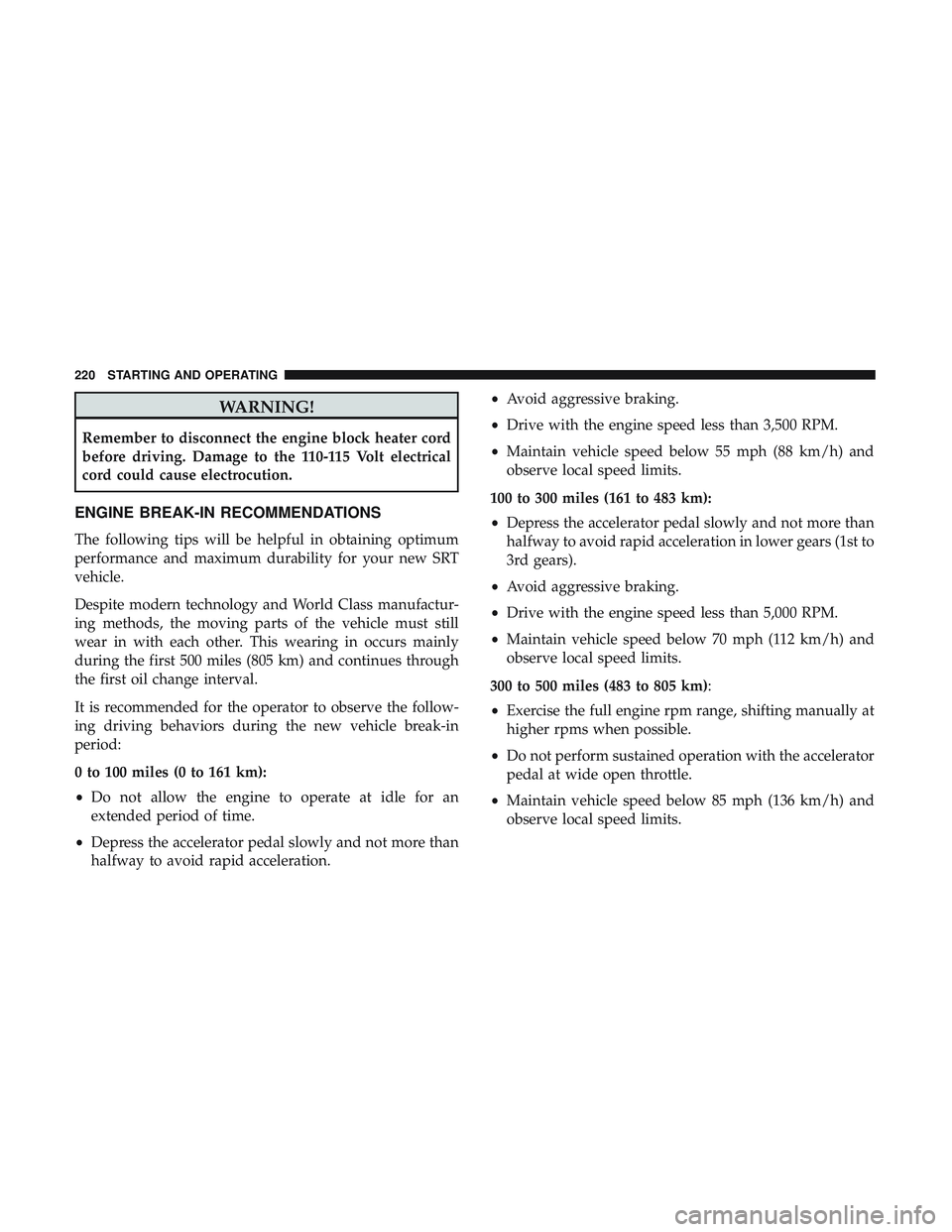
WARNING!
Remember to disconnect the engine block heater cord
before driving. Damage to the 110-115 Volt electrical
cord could cause electrocution.
ENGINE BREAK-IN RECOMMENDATIONS
The following tips will be helpful in obtaining optimum
performance and maximum durability for your new SRT
vehicle.
Despite modern technology and World Class manufactur-
ing methods, the moving parts of the vehicle must still
wear in with each other. This wearing in occurs mainly
during the first 500 miles (805 km) and continues through
the first oil change interval.
It is recommended for the operator to observe the follow-
ing driving behaviors during the new vehicle break-in
period:
0 to 100 miles (0 to 161 km):
•Do not allow the engine to operate at idle for an
extended period of time.
• Depress the accelerator pedal slowly and not more than
halfway to avoid rapid acceleration. •
Avoid aggressive braking.
• Drive with the engine speed less than 3,500 RPM.
• Maintain vehicle speed below 55 mph (88 km/h) and
observe local speed limits.
100 to 300 miles (161 to 483 km):
• Depress the accelerator pedal slowly and not more than
halfway to avoid rapid acceleration in lower gears (1st to
3rd gears).
• Avoid aggressive braking.
• Drive with the engine speed less than 5,000 RPM.
• Maintain vehicle speed below 70 mph (112 km/h) and
observe local speed limits.
300 to 500 miles (483 to 805 km):
• Exercise the full engine rpm range, shifting manually at
higher rpms when possible.
• Do not perform sustained operation with the accelerator
pedal at wide open throttle.
• Maintain vehicle speed below 85 mph (136 km/h) and
observe local speed limits.
220 STARTING AND OPERATING
Page 322 of 500
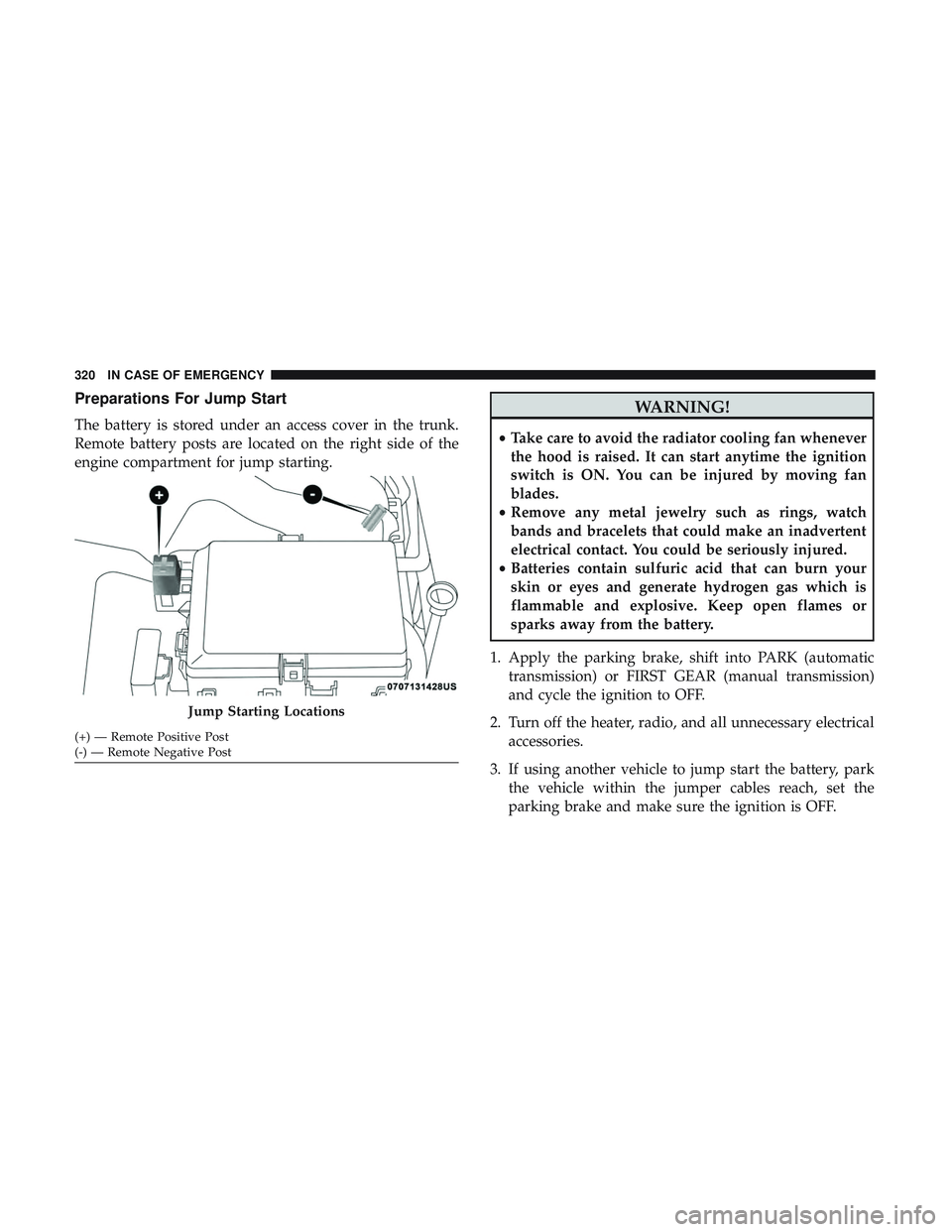
Preparations For Jump Start
The battery is stored under an access cover in the trunk.
Remote battery posts are located on the right side of the
engine compartment for jump starting.
WARNING!
•Take care to avoid the radiator cooling fan whenever
the hood is raised. It can start anytime the ignition
switch is ON. You can be injured by moving fan
blades.
• Remove any metal jewelry such as rings, watch
bands and bracelets that could make an inadvertent
electrical contact. You could be seriously injured.
• Batteries contain sulfuric acid that can burn your
skin or eyes and generate hydrogen gas which is
flammable and explosive. Keep open flames or
sparks away from the battery.
1. Apply the parking brake, shift into PARK (automatic transmission) or FIRST GEAR (manual transmission)
and cycle the ignition to OFF.
2. Turn off the heater, radio, and all unnecessary electrical accessories.
3. If using another vehicle to jump start the battery, park the vehicle within the jumper cables reach, set the
parking brake and make sure the ignition is OFF.
Jump Starting Locations
(+) — Remote Positive Post
(-) — Remote Negative Post 320 IN CASE OF EMERGENCY
Page 324 of 500
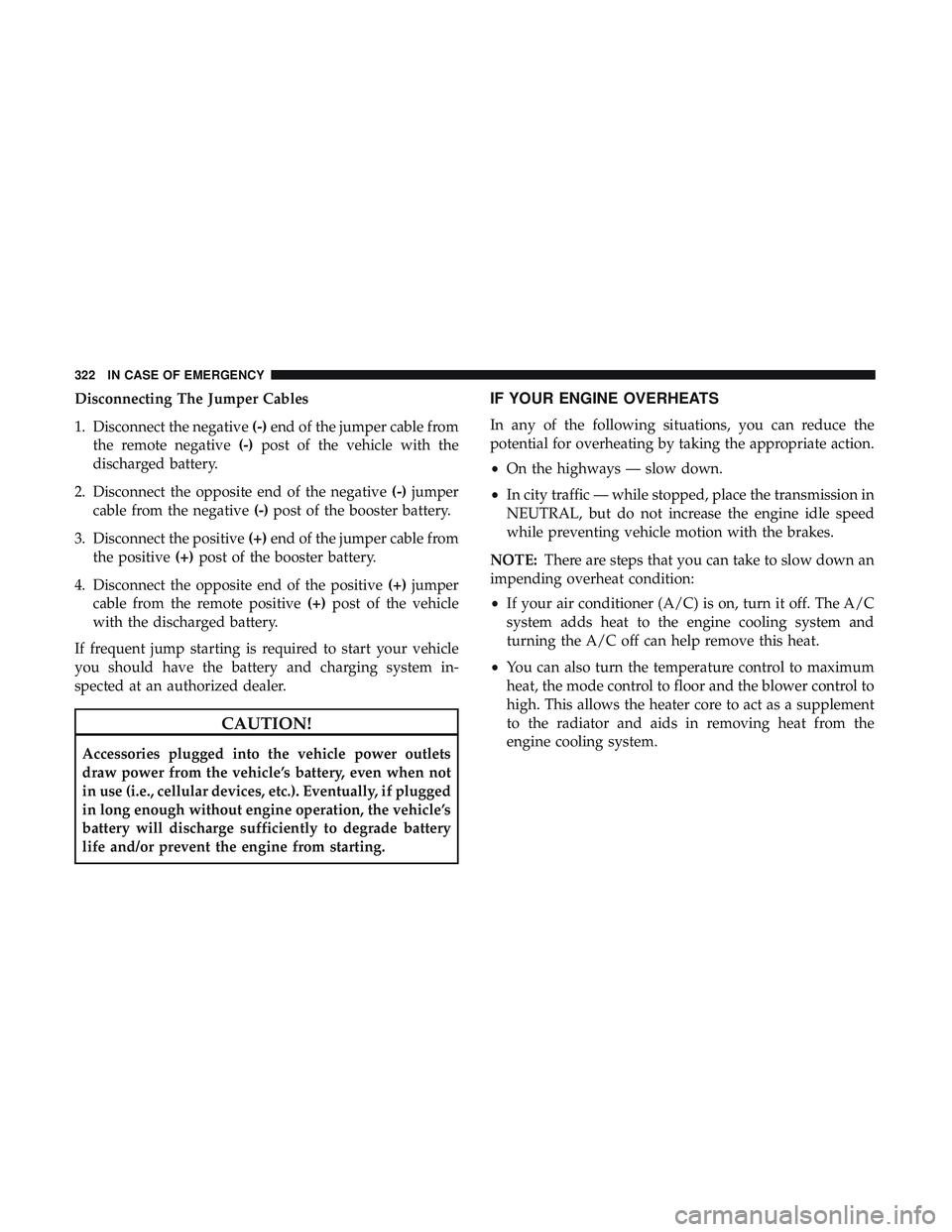
Disconnecting The Jumper Cables
1. Disconnect the negative(-)end of the jumper cable from
the remote negative (-)post of the vehicle with the
discharged battery.
2. Disconnect the opposite end of the negative (-)jumper
cable from the negative (-)post of the booster battery.
3. Disconnect the positive (+)end of the jumper cable from
the positive (+)post of the booster battery.
4. Disconnect the opposite end of the positive (+)jumper
cable from the remote positive (+)post of the vehicle
with the discharged battery.
If frequent jump starting is required to start your vehicle
you should have the battery and charging system in-
spected at an authorized dealer.
CAUTION!
Accessories plugged into the vehicle power outlets
draw power from the vehicle’s battery, even when not
in use (i.e., cellular devices, etc.). Eventually, if plugged
in long enough without engine operation, the vehicle’s
battery will discharge sufficiently to degrade battery
life and/or prevent the engine from starting.
IF YOUR ENGINE OVERHEATS
In any of the following situations, you can reduce the
potential for overheating by taking the appropriate action.
• On the highways — slow down.
• In city traffic — while stopped, place the transmission in
NEUTRAL, but do not increase the engine idle speed
while preventing vehicle motion with the brakes.
NOTE: There are steps that you can take to slow down an
impending overheat condition:
• If your air conditioner (A/C) is on, turn it off. The A/C
system adds heat to the engine cooling system and
turning the A/C off can help remove this heat.
• You can also turn the temperature control to maximum
heat, the mode control to floor and the blower control to
high. This allows the heater core to act as a supplement
to the radiator and aids in removing heat from the
engine cooling system.
322 IN CASE OF EMERGENCY
Page 399 of 500
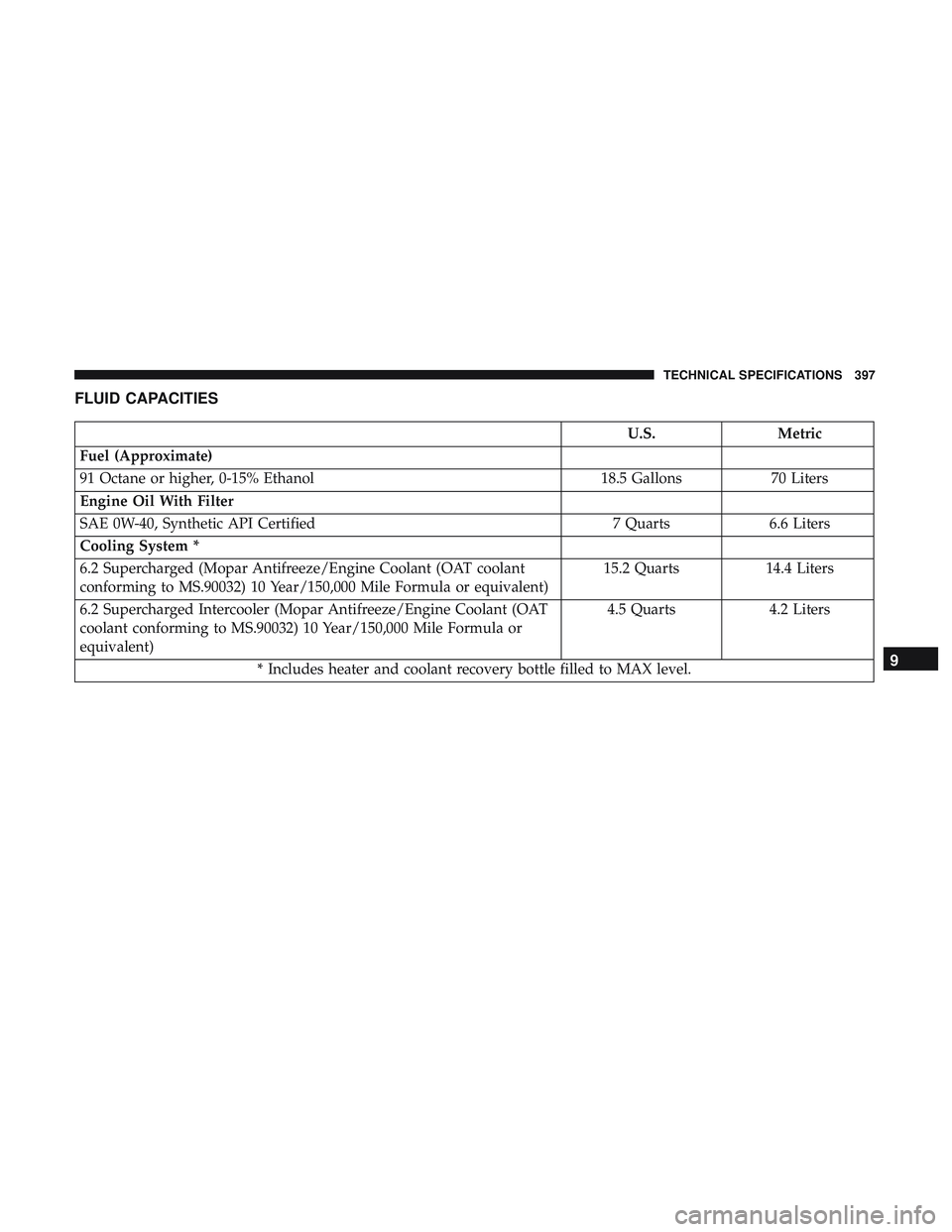
FLUID CAPACITIES
U.S.Metric
Fuel (Approximate)
91 Octane or higher, 0-15% Ethanol 18.5 Gallons70 Liters
Engine Oil With Filter
SAE 0W-40, Synthetic API Certified 7 Quarts6.6 Liters
Cooling System *
6.2 Supercharged (Mopar Antifreeze/Engine Coolant (OAT coolant
conforming to MS.90032) 10 Year/150,000 Mile Formula or equivalent) 15.2 Quarts
14.4 Liters
6.2 Supercharged Intercooler (Mopar Antifreeze/Engine Coolant (OAT
coolant conforming to MS.90032) 10 Year/150,000 Mile Formula or
equivalent) 4.5 Quarts
4.2 Liters
* Includes heater and coolant recovery bottle filled to MAX level.
9
TECHNICAL SPECIFICATIONS 397
Page 487 of 500
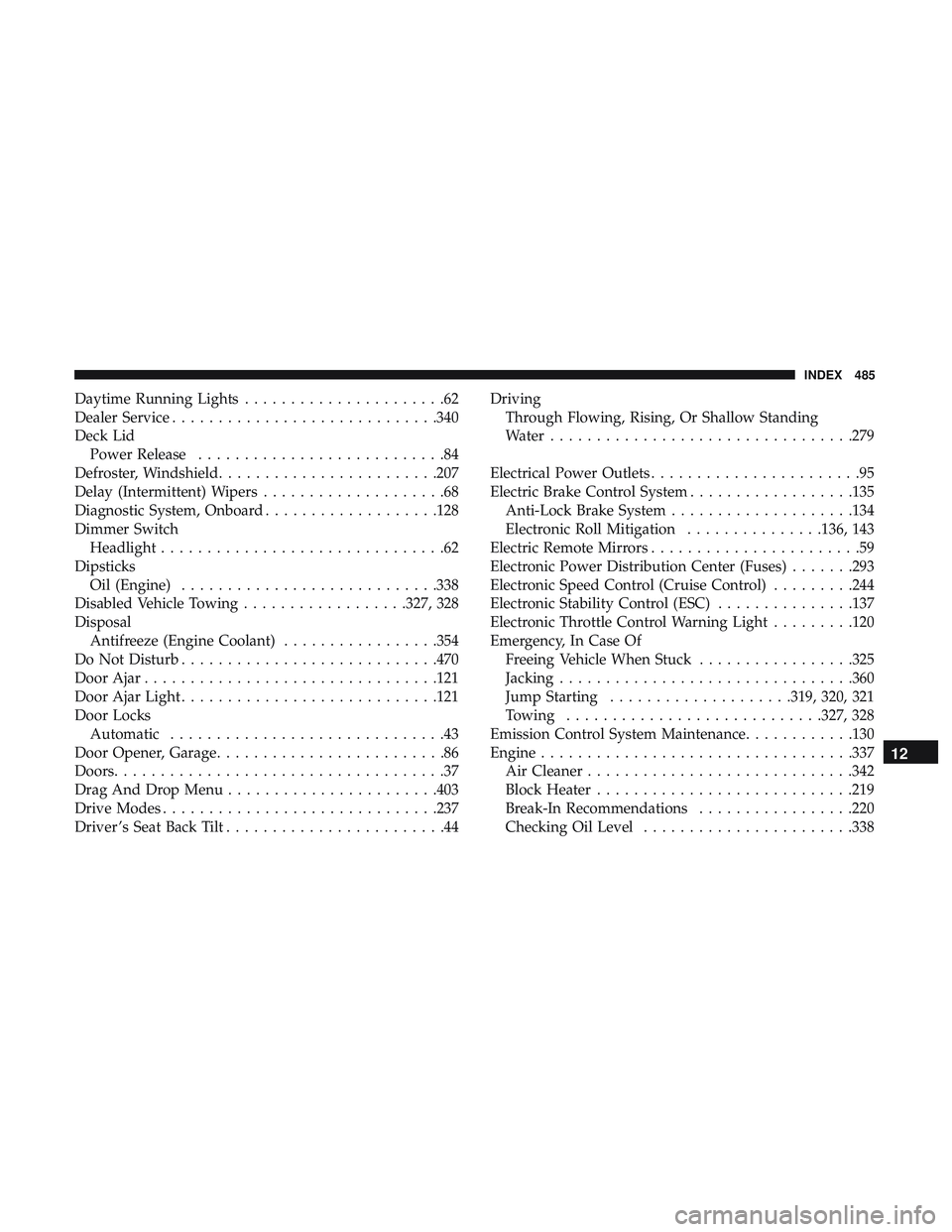
Daytime Running Lights......................62
Dealer Service ............................ .340
Deck Lid Power Release ...........................84
Defroster, Windshield ........................207
Delay (Intermittent) Wipers ....................68
Diagnostic System, Onboard ...................128
Dimmer Switch Headlight ...............................62
Dipsticks Oil (Engine) ............................338
Disabled Vehicle Towing ..................327, 328
Disposal Antifreeze (Engine Coolant) .................354
Do Not Disturb ............................470
Door Ajar ............................... .121
Door Ajar Light ............................121
Door Locks Automatic ..............................43
Door Opener, Garage .........................86
Doors ....................................37
Drag And Drop Menu .......................403
Drive Modes ............................. .237
Driver ’s Seat Back Tilt ........................44 Driving
Through Flowing, Rising, Or Shallow Standing
Water .................................279
Electrical Power Outlets .......................95
Electric Brake Control System ..................135
Anti-Lock Brake System ....................134
Electronic Roll Mitigation ...............136, 143
Electric Remote Mirrors .......................59
Electronic Power Distribution Center (Fuses) .......293
Electronic Speed Control (Cruise Control) .........244
Electronic Stability Control (ESC) ...............137
Electronic Throttle Control Warning Light .........120
Emergency, In Case Of Freeing Vehicle When Stuck .................325
Jacking ............................... .360
Jump Starting ....................319, 320, 321
Towing ............................327, 328
Emission Control System Maintenance ............130
Engine ................................. .337
Air Cleaner ............................ .342
Block
Heater ............................219
Break-In Recommendations .................220
Checking Oil Level .......................33812
INDEX 485
Page 489 of 500

Clean Air............................. .393
Ethanol ...............................393
Filler Cap (Gas Cap) ..................... .274
Gasoline ...............................392
Materials Added ........................ .393
Methanol ............................. .393
Octane Rating ........................392, 398
Requirements .......................... .392
Specifications .......................... .398
Tank Capacity .......................... .397
Fueling ................................. .274
Fuses .................................. .292
Garage Door Opener (HomeLink) ................86
Gas Cap (Fuel Filler Cap) .....................274
Gasoline, Clean Air ........................ .393
Gasoline, Reformulated ..................... .393
Gear Ranges ............................. .231
Glass Cleaning ............................388
Gross Axle Weight Rating .....................276
Gross Vehicle Weight Rating ...................276
GVWR ................................. .276Hazard
Driving Through Flowing, Rising, Or Shallow Standing
Water .................................279
Hazard Warning Flashers .....................283
Headlights Automatic ..............................63
Cleaning ...............................385
High Beam/Low Beam Select Switch ...........62
Lights On Reminder .......................64
On With Wipers ..........................63
Passing ................................62
Switch .................................61
Time Delay ..............................63
Washers ...............................338
Head Restraints ............................52
Head Rests ................................52
Heated Mirrors .............................59
Heater ...................................70
Heater, Engine Block ........................219
High Beam/Low Beam Select (Dimmer) Switch ......6
2
Hill Start Assist ............................141
HomeLink (Garage Door Opener) ................86
Hood Prop ................................82
Hood Release ..............................8212
INDEX 487